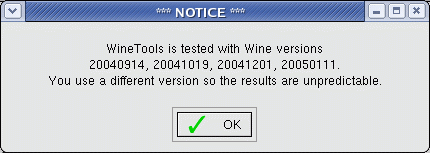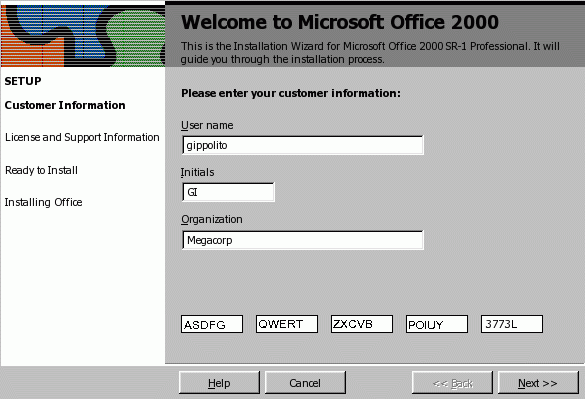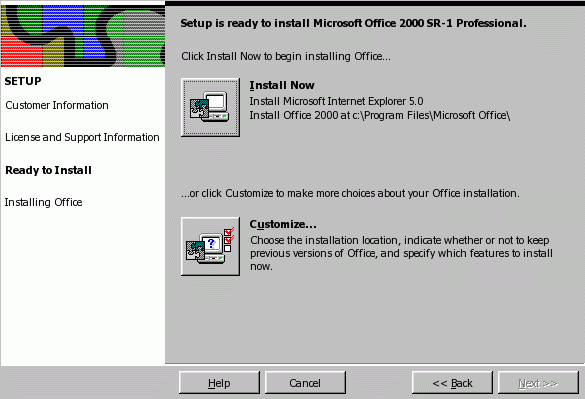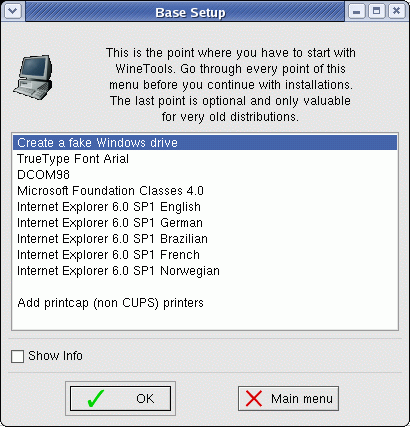Running Microsoft DOS and Microsoft Windows Software on Linux
WINE installation, configuration and use.
This tutorial covers «WINE», the Linux software which allows one to run Microsoft DOS and Microsoft Windows applications on a Linux system. The installation and use of Microsoft Office on Linux is covered in this tutorial with both the free and commercial versions of WINE.
Software systems which enable Microsoft Windows applications to run on a Linux OS:
- DOSemu.org — DOS emulator home page
- DOSbox — DOS emulator home page
- WINE — Subsystem to run Microsoft Windows programs. It allows Linux to handle Windows API calls natively. (not an emulator) (OSS) I could never get Outlook 2000 to run under the open source version of wine. (Use Crossover’s commercial release of WINE below.)
- CodeWeavers.com — Commercial version of Wine (Crossover) which can run Microsoft Office 2000. While this is my favorite method of running MS/Windows apps on linux it will not run all Microsoft applications and does not run them all equally well. This method does NOT require a license and installation of the MS/Windows OS. The apps run natively on Linux using WINE to handle Microsoft OS calls. This method has the best integration with Linux as it has full access to the Linux file system. (Reads and writes all files to the Linux file system.)
- WineX — Wine with DirectX API extensions to support games.
- Cedega TransGaming.com — Commercial version of WineX
- Rewind — MIT/X11 fork of Wine project.
- Win4lin: (discontinued product) Linux version of SCO Unixware Merge — Requires Windows operating system. (Commercial product) — I loved the SCO Merge product!! Lacks NETBIOS networking support. No DirectX support but does give you native Linux filesystem access which VMWare does not. Requires MS/Windoew OS license.
- VMWare — Virtual x86 Intel machine to run any Intel operating system including Windows. (Commercial product) No access to Linux file system. Must interface with Linux through network. Requires MS/Windoew OS license. Only method to be able to run any Microsoft application.
- BOCHS — Virtual x86 Intel machine. (OSS) Run x86 operating systems on top of/concurent with Linux.
- QEMU x86 Emulator — Run Wine on non-x86 architectures.
- VBVM — Visual Basic Virtual Machine — run a .EXE file produced by VB5 or VB6
- Other Virtual Machine technologies: OpenVZ, KVM: Kernel Based Virtual Machine (requires hardware support: Intel VT or AMD-V)
Related YoLinux Tutorials:
The Wine compatibility layer is an implementation of the Microsoft API on X-Windows which allow Linux to run Microsoft Windows application. The limitation is that since the Microsoft applications have been compiled to run on Intel 32 bit architectures, Wine is limited to the same architecture. The executable will run natively in Linux. Wine is NOT a virtual machine. Thus Wine does NOT read each binary instruction. Wine does NOT require the installation of the Microsoft Windows operating system. The Microsoft Windows application will run on Linux executing its Intel binary instructions. The Wine compatibility layer is invoked every time the application makes a call to a Microsoft Windows API function. Wine will handle the call and make the appropriate X-Window call to display or render the appropriate graphics.
This particular example is for Wine version 0.9.42 on Red Hat Enterprise Linux 5, but other versions of Linux should be similar.
Wine Installation: (as root)
- wine: Empty but contains dependency information
- wine-core: Wine core package
- wine-capi: ISDN support for wine
- wine-cms: Color Management for wine
- wine-devel: Wine development environment
- wine-esd: ESD sound support for wine
- wine-jack: JACK sound support for wine
- wine-ldap: LDAP support for wine
- wine-nas: NAS sound support for wine
- wine-tools: Additional wine tools
- wine-twain: Twain support for wine
All packages were required to support dependencies.
- Red Hat: rpm -ivh wine-0.9.42-1.el5.i386.rpm wine-core-0.9.42-1.el5.i386.rpm wine-docs-0.9.42-1.el5.noarch.rpm wine-tools-0.9.42-1.el5.i386.rpm wine-capi-0.9.42-1.el5.i386.rpm wine-jack-0.9.42-1.el5.i386.rpm wine-cms-0.9.42-1.el5.i386.rpm wine-esd-0.9.42-1.el5.i386.rpm wine-ldap-0.9.42-1.el5.i386.rpm wine-nas-0.9.42-1.el5.i386.rpm wine-twain-0.9.42-1.el5.i386.rpm
(EPEL: Extra Packages for Red Hat Enterprise Linux — Wine for RHEL/CentOS 5/6)
or YUM: yum install wine - Ubuntu/Debian: apt-get install wine
Configuring the APT repository for obtaining Wine
Wine Configuration: (install to users home directory)
Note: By default, Wine installs to the user’s home directory. This is a problem for many users connected to a file server. Both a user’s home directory installation and a site wide installation are covered.
- Configure with Wine GUI tool: /usr/bin/winecfg
/userX/.wine/ and the following:
- sub-directories:
- Com port: ln -s /dev/ttyS0 com1
- Printer: ln -s /dev/lp0 lpt1
Device configuration: By default, winecfg will generate your devices such as your «C:» drive, CD-ROM «D:», etc
While your devices are configured automatically, you can manually add devices. eg:
Linux CUPS printing should auto-configure and work.
/.wine/system.reg to set the application owner and organization. This is specified in two locations. Edit both:
System wide installation for all users:
Insert the CD-ROM and execute the following command to launch the MS/Office installer:
- Installing MS Office 2003: wine /media/cdrecorder/setup.exe
- Installing MS Office XP: wine /media/cdrecorder/SETUPPRO.EXE
- Installing MS Office 2000: /media/cdrecorder/setuppro.exe
I found that the only version of MS/Office which will install properly under Wine 0.9.42, was MS/Office 2000. Check the Wine list of working applications as success is kernel and release specific.
- Launch MS/Office 2000 installer: /media/cdrecorder/setuppro.exe
Follow installation sequence:
Run Microsoft Office applications on Linux:
- MS/Word:
- Alternate location: wine /opt/WINE/drive_c/Program\ Files/Microsoft\ Office/Office/WINWORD.EXE
- Default location: wine
/.wine//drive_c/Program\ Files/Microsoft\ Office/Office/WINWORD.EXE
- Default location: wine
/.wine//drive_c/Program\ Files/Microsoft\ Office/Office/EXCEL.EXE
- Alternate location: wine /opt/WINE/drive_c/Program\ Files/Microsoft\ Office/Office/EXCEL.EXE
- Default location: wine
/.wine/drive_c/Program\ Files/Microsoft\ Office/Office/POWERPNT.EXE
- Alternate location: wine /opt/WINE/drive_c/Program\ Files/Microsoft\ Office/Office/POWERPNT.EXE
- Man pages available: wine, wineserver, wineprefixcreate
- Microsoft Office can be uninstalled using the GUI program: uninstaller
- A Wine version of «regedit» is used to manually edit the registry. In fact it looks and operates just like the MS/Windows version of «regedit».
Command: /usr/bin/regedit
List «wineserver» processes: ps auxw | grep wine wineserver -k[n] Kill the current wineserver, optionally with signal n.
wineserver -k29604
Other processes to watch for/kill: explorer.exe
- mkdir appname
- WINEPREFIX="/home/userX/appname" wineprefixcreate
This will create a directory called /home/userX/appname. In this directory you will find a fake Windows drive and the Wine configuration files system.reg and user.reg. - Command to install the application: WINEPREFIX="appname" wine setup.exe
- Run application: WINEPREFIX="/home/userX/appname" wine
/appname/drive_c/Program\ Files/app/appname.exe
For a fresh copy of the default config file:
cp /usr/share/doc/wine-xxxxxxxx/samples/config
/.wine/config
Add the parameter «unhide».
- cd /mnt/cdrom
- wine INSTALL.EXE
- DLLOVERRIDES="ole32=n;oleaut32=n;rpcrt4=n" wine INSTALL.EXE
Make a note of which version of Wine should be used with WineTools. WineHq.com will release newer versions of Wine which are not compatable.
rpm -ivh winetools-2.1.2-jo.i386.rpm
rpm -ivh xdialog-2.1.2-1.1.fc3.rf.i386.rpm
- Fedora Core users: Turn off pre-linking (as root)
- prelink -uav
- rm -f /etc/prelink.cache
To turn back on: /etc/cron.daily/prelink
- True type font (.ttf) files can be placed in . /drive_c/windows/fonts/
- Start Wine configuration program as regular user: /usr/local/bin/wt2
- Select «OK» to get to «Base setup».
Select each item and then «OK». Only one language needs to be selected.
Note: True Type Arial font installation requires an internet connection. — Don’t do this step.

The only way to run some of the advanced and more complex MS/Windows XP games and aplications with Wine, is with the commercial product, Code Weavers Crossover version of Wine. You can try the 14 day trial version for free. Installation of Wine and Microsoft Office 2003 and 2000 are covered below. Note that Outlook requires the following instructions to operate properly as Outlook needs MS/Explorer in order to provide all the proper libraries. This product allows seamless integration of Microsoft applications on Linux.
Codeweaver Crossover and Microsoft Office 2000 Installation:
- Download 30 day trial version or purchase licensed version from Codeweavers
- As root install Crossover RPM: [prompt]# rpm -ivh cxoffice-2.0.1-1.i386.rpm
or install from install shell script for Linux distributions which do not support RPMs.
Installs to: /opt/cxoffice/
Docs: /opt/cxoffice/README, /opt/cxoffice/doc/index.html
Uninstall: /opt/cxoffice/bin/cxuninstall
Support: http://www.codeweavers.com/support/ - Start/prepare Crossover: (login as user)
- Start Crossover Office Setup (2.0.1)
- [prompt]$ /opt/cxoffice/bin/cxsetup
- Next
- Proxy setup if required:
- Select «Use HTTP Proxy»
- Host: proxy.megacorp.com
- Port: 80
Finish
- Start Crossover Office Setup (2.0.1)
- Install Office 2000: Run Microsoft Office setup installer program.
- Select «Microsoft Office 2000»
- New Software: Select Install
Select «Microsoft Office 2000»
Next - Install from «Microsoft Office installation CD» or choose «Alternate CD-Rom location»
(Note: You have the option of installing from sources other than the CD. i.e. shared drive. See the Yolinux Microsoft network integration tutorial if you need to mount a MS/Windows file server.)
Press «OK»
Next
Continue
- Now MS Windows Installer pops up. Install Office 2000.
- Enter: Name, initials, organization and CD key.
(Note: You may have to enter the letters of the license key as lower case letters.)
Next - Accept license
Next - Install default to «Program Files»
Finish
- Enter: Name, initials, organization and CD key.
- Install «DECOM95»
- Click Install
- Select «*DECOM95»
Next - Select radio button «Advanced Install».
Next - Install file: /mnt/cdrom/IE5/EN/DECOM95.EXE
Open
Next
Finish
- Install IE:
- Install
- Check the checkbox labeled «Install unsupported software»
Next - Other exe file: /mnt/cdrom/IE5/EN/IE5SETUP.EXE
Open
Next - Yes resume setup
Next
Finish - Finish
Note: The Microsoft Office installation wizard will display a pop-up message box requesting: «reboot computer». This is a message for users of the Microsoft operating system which require a reboot to read the new registry settings. This is NOT required for Linux users. Do not reboot your system. Crossover will perform a restart of it’s software which will re-read the Windows applications registry.
Configure/Run Microsoft Application: Outlook
- Configure:
- Select «Menus» tab and select Outlook icon
or use regular applications start menu.
- Select «Menus» tab and select Outlook icon
- Run:
- Outlook startup: Email service options: Corporate or Workgroup
Next - Inbox Setup wizard: Select «Microsoft Exchange Server»
Next - Settings:
MS Exchange Server: Node-Name-Of-Server
Mailbox: login-user-id
Next - Travel: No
Next - Exchange server
Finish - User: login-user-id
Domain: WINDOWS-DOMAIN
Passwd:
OK
- Outlook startup: Email service options: Corporate or Workgroup
If you do not install IE5, Outlook will not work. Microsoft Internet Explorer is not installed as part of the Microsoft Office installation and must be installed separately.
Cutting and pasting between Linux X-Windows and Microsoft Windows applications:
- MS/Windows to X/Windows:
Cut in MS/Windows: Select text then ctrl-C (copy) or Cnlt-X (cut)
Paste in X/Windows: press middle mouse button. (both left and right at the same time if using a two button mouse emulating a three button mouse) - X/Windows to MS/Windows:
Cut in X/Windows: Select text (left mouse button pressed from start of text to end of text, or double click to grab single word or tripple click to grab entire line of text.)
Paste in MS/Windows: ctrl-V
- Microsoft applications running on Crossover Office will not view Linux file/directory soft links in the file selection browser.
- Starting Windows Media Player: $HOME/.cxoffice/.cxoffice-app-3 ms-windows-media-video-file.wmv
- I had NO luck trying to even launch let alone run MS/Project 2000 with Crossover 2.0 but it works great with the new Crossover 3.0.
- FC 3: $HOME/Desktop/Visio.desktop
- RH 7/8/9: $HOME/.gnome-desktop/Visio.desktop
Visio Tip: A screen repaint is often necessary after an image translation using the scrollbar. I create an extra sheet. I select the second sheet and then return to the sheet I’m working on to force a repaint the screen.
- Turn off the «Office Assistant» paperclip.
Tips:
- I found that I had to remove the previous versions of the files /opt/cxoffice/bin/wineserver, /opt/cxoffice/bin/wineloader and /opt/cxoffice/lib/xml/libperl.so.5.8 in order to have a flawless upgrade.
- Un-zip and install from a directory other than your target destination directory.
Crossover Upgrade (3.0): rpm -Uvh --force xoffice--------.rpm
Change Note: The opperation of Linux cut and paste has switched to a more Microsoft Windows like buffer interface. In Crossover 2.X one could cut into the regular X-Window copy/cut buffer with the left mouse button and then paste in the Crossover 2.X application with the traditional ctrl-V. The X-Window applications now have to support a special non-X-Window controlled cut buffer. For example Mozilla supports the Linux ctrl-C/ctrl-X copy/cut buffer. The GNOME terminal supports copy/cut with shift-ctrl-C/shift-ctrl-X. These Linux buffers can be exchanged with a Crossover 3.0 application. The traditional X-Window copy/cut buffer can no longer be exchanged with Crossover controlled applications.









